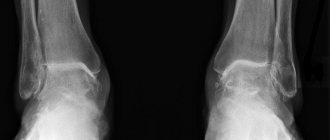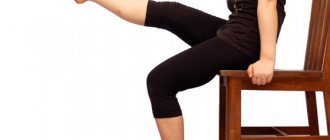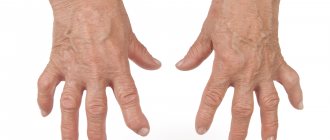The foot serves as a support for the entire lower limb. If it is damaged, the person is forced to walk on crutches and undergo long-term treatment.
No one is immune from sprains and ruptures of ankle ligaments, fractures and bruises of the foot. Such injuries are possible not only during sports, but also in everyday life: when a leg is twisted, an object is knocked over on the leg, or there is a strong blow.
If you suspect a foot bruise, you should contact a medical facility: a hospital or emergency room: a minor injury can lead to serious consequences and complications.
In advanced cases, a child's foot bruise becomes a cause of disability.
Symptoms of a foot bruise
The clinical picture helps determine the type of injury the patient has. The foot is a sensitive area of the body, so if it is damaged, the following symptoms immediately appear:
- Pain. There are many nerve endings and blood vessels in the foot. When bruised, a sharp sharp pain immediately occurs. Over time it becomes dull.
- Swelling. Bruise is damage to soft tissue. Cell integrity is compromised and the amount of interstitial fluid increases. All this leads to swelling and visible swelling.
- Hematoma. Occurs when the wall of blood vessels is damaged. The color of the formation changes over time: the fresh one has a purplish-blue tint, after a couple of days it becomes blue-yellow, and after a week it turns yellow, losing its intensity.
- Local hyperemia. The skin in the area of the bruise heats up due to increased blood flow.
- Fluctuation. If you receive a tangential blow to the foot with a blunt object, the periosteum or subcutaneous fat may peel off. The resulting void is filled with lymph, blood or exudate. On palpation, it is defined as a cavity with elastic walls, inside of which there is liquid. This is a symptom of fluctuation.
Severe, sharp, unbearable pain may indicate ligament and muscle rupture, as well as nerve damage or pinching. You should not endure discomfort: you need to urgently consult a doctor to avoid serious complications.
Fractures
Most often, the cause of a fracture is an unsuccessful jump or a fall on the leg. When the bones of the posterior section are fractured, fragments may become displaced, compressing the tendons and skin, thereby disrupting their blood circulation. The result is necrosis of the tissues of the foot. The first symptoms of such an injury are severe pain, swelling and bruising under the ankle joint. When pressing upward on the heel, you may feel increased pain.
Such a fracture requires urgent medical attention. It is very important to get to the hospital before swelling begins to occur and develop. In this case, you need to immobilize the leg with a splint, elevate it and apply ice.
If the fracture occurs in the heel bone, the tissue in the heel area swells, the foot flattens, and the tendon smoothes out. At the same time, the heel visually expands. Even with a light touch on the affected area, pain is felt.
If the metatarsal bones, which form the forefoot, have been broken, the pain intensifies when pressed and bleeding increases.
If fingers are injured, then most often the skin is damaged. In the area of damage, hemorrhage under the skin is visible, severe pain in the fingers is noted, and its axis and mobility change.
When providing assistance in case of a phalanx fracture, you need to remember some features. To immobilize your finger, you need to use an adhesive bandage. To do this, take a wide adhesive plaster, which is wrapped around the fingers several times. If several fingers are affected at once, then such manipulation is carried out for each finger separately.
With bruises of the joint and ligaments, pain and swelling occur in the ankle area. In this case, all movements in the joint are limited. But the victim may step on his foot. The first aid in this case is to apply ice and elevate the limb. In addition, the joint must be secured with a tight bandage.
For these purposes, you can take an elastic bandage or a special product - a joint fixator.
There are also special splints that are applied for severe bruises and tissue swelling. These splints are inflated and help immobilize the limb.
When a ligament ruptures, in addition to severe pain and swelling, a bruise appears. If the bruise is not very large, then the ligaments are not completely damaged. In this case, it is enough to apply a bandage. If the bruise is extensive, then this will not be enough. In this situation, you will need to fix the joint with a splint.
Provoking factors
The foot plays a big role in the static-dynamic balance of the body. It functions as a support, so often the etiology of a foot injury is associated with awkward movements or overload of the muscular-ligamentous apparatus of the leg.
The main causes of foot bruises:
- Impact with a heavy blunt object. Here we are talking about direct mechanical damage to the tissues of the leg. Cases of road accidents are especially dangerous.
- Dislocation. It is often the result of an unsuccessful landing after a jump or fall, as well as wearing high-heeled shoes. People with underdeveloped ligaments are prone to dislocations, which is typical for mesenchymal dysplasia.
- Foot overload. All athletes have had injuries at least once. Since the ankle is a support for the body, its injuries are most common.
- Impact of the foot on an object. By kicking something heavy or hard, a person can get not only a foot bruise, but also a fracture. This type of injury is most relevant for young football players: children’s fragile ligaments are easily injured.
The high-risk group includes patients with weakened ligamentous-muscular apparatus. They are more likely than others to injure the foot and its joints.
How to distinguish a foot bruise from a fracture?
Differential diagnosis is carried out by a doctor. To distinguish between the pathologies under consideration, it is first necessary to clearly define these terms.
A bruise is a closed injury to soft tissues without gross disruption of their structure. The outer coverings are not affected.
A fracture is a type of injury that includes partial or complete disruption of the integrity of the bones. It can be open (accompanied by rupture of the skin and exposure of bone) or closed (without these symptoms).
| Type of injury | Injury | Fracture |
| What is damaged | Soft fabrics | Bone structures and surrounding tissues |
| Nature of pain | Intense sharp, fading later | Strong, persistent |
| Swelling | Eat | It does not appear immediately, but after some time. More pronounced |
| Hyperthermia | Present | Eat. May cover part of the lower leg |
| Hematoma (bruise) | + | + |
| Range of motion | Limited. You can lean on your foot, but it hurts to walk | Excessive unnatural mobility, accompanied by unbearable pain. The limb becomes inoperative |
| Other symptoms | Fluctuation is an additional sign of a foot contusion, observed in rare cases | When you try to move your foot, you hear a “crunching” sound – crepitus (bone fragments touch each other). Deformation of the foot in the area of the fracture. With an open type of injury, bone fragments are visible. |
| Rehabilitation time | 1 to 3 weeks | A few months. The duration is variable and depends on the complexity of the fracture |
The doctor makes a final diagnosis only after examination, palpation, taking an anamnesis from the patient and studying an x-ray of the foot.
Child's foot injury
Children are active. Their love for outdoor games often leads to bruises and abrasions. If a child’s foot is injured, the algorithm for providing assistance is as follows:
- If the integrity of the skin is compromised, then it is necessary to treat the cover with an antiseptic.
- Ensure complete rest. You cannot stand on a bruised leg.
- A tight bandage is applied to the foot using an elastic bandage.
After providing first aid, you must contact a traumatologist.
It is unacceptable to take a warm bath or apply a hot compress to the injury site: these activities will increase the pain and swelling.
Possible consequences of a bruise
In most cases, the bruise does not have any serious consequences, and pain, bruising and swelling disappear within a few weeks. In more serious situations, complications may arise, such as: neuritis, periarthritis, traumatic synovitis, problems with mobility, etc.
If you have concerns about a heel bruise, a medical examination will help determine the nature of the injury. Patients usually come to this decision some time after the injury, when it becomes clear that the painful symptoms do not go away.
First aid for bruise
To prevent the development of complications in case of a foot injury, it is necessary to go to the hospital as soon as possible. Before the victim goes to the doctor, it is recommended to perform a number of simple manipulations:
- Provide motor rest to the injured leg. You cannot rely on a limb!
- Apply a fixing bandage. The best material for this purpose is an elastic bandage. If it is not there, any fabric can be used. The bandage is applied tightly, but without pinching the blood vessels.
- Apply a cold compress. They can serve as ice wrapped in a rag or frozen food. Cold constricts blood vessels, which will reduce the likelihood of swelling and hematoma. The compress is applied for no more than 20 minutes, after which you should take a five-minute break.
Provide motor rest to the injured leg. You cannot rely on a limb!
This type of first aid is provided if there is confidence that it is a bruise. If a fracture is suspected, a splint is applied to ensure complete rest of the foot.
You should not take medications (especially painkillers) before seeing a doctor: this may distort the clinical picture or hide possible complications.
Bruises and dislocations
Foot bruises are accompanied by severe pain, since the layer of skin and muscle is very thin, and the blows fall on the periosteum - the connective tissue that covers the bone. After this, swelling quickly appears, which increases over time. That is why first-aid is necessary to reduce swelling and pain. To do this, you can put ice on your foot and try not to put any strain on your foot.
Foot sprains are quite rare. The external sign may depend on which joint the injury occurred in. If there is a dislocation in the subtalar joint, then the following signs appear: the foot is atypically shifted and the sole is turned inward, the outer ankle is extended and stretched skin is visible above it. The inner ankle, on the contrary, is deepened and the skin is retracted.
Swelling occurs fairly quickly with dislocations. It makes reduction very difficult, so it is important to transport the injured person to a trauma center as quickly as possible. You should not adjust the dislocation yourself, as this action cannot be carried out without anesthesia.
Content:
- Bruises and dislocations
- Fractures
- First aid
During transportation, you should immobilize the injured limb using a splint or other available means, place it on a cushion and apply something cold. Under no circumstances should you step on or lean on this limb, as the pain may intensify and the displacement may worsen.
Sprains in the forefoot and midfoot cause swelling and deformity of the leg. First aid should be the same as for this problem in other joints.
If there was a direct blow to the foot, which is accompanied by severe pain and increasing swelling, then it can cause both a bruise and a dislocation of the foot. Externally they are difficult to distinguish. In case of such injuries, the victim must be taken to a trauma center.
Diagnostics
If your foot is injured, you should first go to an emergency room or clinic. Only a specialist can reliably determine the nature and extent of the injury.
Despite the fairly clear clinical picture of the bruise, to make a diagnosis, the doctor will need the following types of examination:
- Palpation.
- X-ray of the foot in two projections.
After the described manipulations, the diagnosis is confirmed by a traumatologist. If necessary, a consultation with a neurologist and orthopedist is scheduled.
Treatment of a heel bruise
Many people try to cope with the consequences of a bruise on their own. In such cases, the following is done:
- the load on the leg is minimized, and ideally, complete rest is ensured;
- the leg should be in an elevated position for blood flow;
- a cold compress is applied to the site of the injury;
- if there is complete confidence in the absence of a fracture, then a pressure bandage can be applied;
- After a few days, warm compresses are used to promote the resorption of the hematoma.
If you find it necessary to go to a medical institution, the doctor must first conduct a diagnosis: interview and examine the patient, and send him for an x-ray.
Even if nothing serious is found, the specialist will recommend medications and procedures that will help quickly cope with pain and swelling. Thus, physiotherapeutic measures (UHF, electrophoresis) are quite effective in such situations, for which you will need to regularly visit a medical facility.
As for drug treatment, analgesics and various ointments are prescribed to help reduce the hematoma.
Treatment
A foot bruise does not require complex therapy. Usually the doctor prescribes treatment at home. In rare cases, surgical intervention is necessary: with an extensive hematoma or large-scale detachment of the skin and subcutaneous fat.
Conservative methods
After first aid, basic therapy follows. It includes taking medications:
- Analgesics. Relieves pain.
- Non-steroidal anti-inflammatory drugs. Suppress the inflammatory process.
- Antihistamines. Eliminate swelling.
- Absorbable agents: antibiotics, sodium heparin, diphenhydramine. They are used in the form of ointments and gels on the affected part of the leg. Helps relieve swelling.
After the most acute phenomena have subsided (swelling, pain), it is recommended to carry out physiotherapy procedures: UHF, warm compresses, rubbing, electrophoresis with medications.
Therapeutic physical education (PT) is used at the rehabilitation stage.
Folk remedies
They knew how to effectively treat a foot bruise in the old days. In addition to traditional medicine, recipes proven by many years of experience can help with foot injuries. For greater safety, consultation with a doctor is required.
Aloe
Bruising can be quickly treated with a tincture of this plant. In 1 liter of vodka or alcohol you need to soak 100 g of crushed aloe leaves and 200 g of sugar. Close the lid of the container tightly. After 3 days, the tincture can be used.
Linden
Lotions made from a decoction of the plant accelerate the resorption of hematomas and relieve pain. Preparation: Soak 2 teaspoons of dry linden leaves in boiling water and let it brew for 30 minutes.
Vinegar
The garlic is ground into a paste and poured with apple cider vinegar. The resulting mass is applied to the bruised area.
Burdock
Burdock root often appears in folk recipes. Add 75 g of the plant to 1 glass of vegetable oil. The solution is infused for a day, after which it is heated over medium heat and can be used to lubricate the injured area.
Salt foot baths
200 g of salt are dissolved in 1 liter of hot water. The injured leg is immersed in the solution for 5 minutes. The method quickly relieves swelling if the foot is very swollen due to a bruise.
Compresses
In the first two days, a cold compress is used to relieve pain. After the acute manifestations subside, a warming procedure can be performed.
How to treat a foot bruise?
There is no need to treat minor foot bruises as most cases go away on their own within a few days. However, if the injuries are more serious, you may not need medical attention. A severe foot bruise must be treated, otherwise there is a risk of complications that will remain unchanged throughout life.
In some cases, it is necessary to urgently go to the hospital after an injury, regardless of its severity. Risk groups include:
- children,
- aged people,
- people with chronic diseases.
Bruises are quite common in children. What should you do if you see a bruise on your foot and suspect it is a bruise? It is extremely important to take your child to the hospital immediately for a medical examination. The trauma surgeon will carefully examine the foot and, upon palpation, apply a bandage to the injured limb.
If no complications are detected, the doctor will recommend treating the bruised leg at home. For this purpose, various drugs or traditional medicine recipes are prescribed. Most often, ointments with a cooling and analgesic effect are prescribed to treat a child’s bruised foot. It is prohibited to use drugs with warming properties.
Medicines
Medicines are the most effective treatment for bruised feet. Today the pharmaceutical market is so diverse that you can find a cure for any ailment. You can choose either a new drug or an old one, tested by your grandparents.
Do not prescribe home treatment if you have a complex injury. The doctor will select a list of medications depending on the severity and characteristics of the injury.
If you have a mild foot bruise, you can treat your foot with a gel, cream, ointment, or other medication yourself. The most popular drugs that can easily be found in pharmacies are:
- "Lediaga Forte"
- Vishnevsky ointment,
- heparin ointment,
- "Traumel,
- Balm “Savior”.
Our ancestors also actively used Vishnevsky ointment and heparin ointment to treat leg bruises. These are quite effective and inexpensive means that quickly heal wounds. Their only drawback is the unpleasant smell. Modern pharmacies offer good drugs with a more pleasant smell.
Traumeel - ointment for bruises
In addition to products for external use, tablets are also prescribed. This is important if the patient is experiencing severe pain. The most commonly prescribed drugs are Ketanov, Analgin and newer painkillers.
The wound at the site of injury should be regularly washed with running cool water and treated with hydrogen peroxide or iodine.
Foot bruise: folk remedies
We already know how to treat foot bruises using modern pharmaceuticals. But this is not the only way out. Traditional medicine recipes do an excellent job of healing even the most severe wounds. However, this does not mean that you cannot contact a specialist. First aid and examination by a trauma surgeon are mandatory.
Folk remedies are aimed at getting rid of the symptoms of a bruise, including swelling:
- Onion wrap. Finely chop the onion or grind it into a paste and put it in cheesecloth. This compress should be applied to the bruise at night.
- Aloe juice with added sugar will get rid of bruises in a short time. After the product has infused (at least 10 hours), it can be applied to the bruise three times a day.
- A great way to get rid of a bruise is to make balms from linden or celery.
- An old recipe that comes from childhood is pulp from the leaves or plantain.
These are the simplest ways to combat the symptoms of a bruise. Raw potatoes, apple cider vinegar, mother and stepmother, tincture of calendula and wormwood are also used for this purpose.
Rehabilitation
It is not enough to cure a bruise: to fully restore the functions of the foot, you will need the help of restorative medicine.
The time frame for returning to full functionality is determined individually. They usually range from 3 days to 4 weeks.
The basis of rehabilitation is physical therapy. Exercise therapy is divided into three periods:
- Immobilization. The main tasks at this stage are to improve blood circulation (promotes tumor decline) and stimulate tissue regeneration. A pleasant addition is the increase in the overall tone of the body. The set of measures is simple: self-massage of the sole and bruised surface, independent movements of the fingers to engage the muscles, and a dosed load on the foot while maintaining the use of crutches.
- Rehabilitation. The goal is to restore the support-spring functionality of the foot (normal fullness of movement). Swimming is very effective. In exercise therapy classes, the range of permissible exercises expands; their main focus is the resumption of proper walking.
- Final. They move to this stage when the patient can calmly step on the foot and moves well without the help of crutches or other additional support. The main task is to strengthen the muscles and ligaments of the foot.
Physiotherapy is acceptable not only as the main treatment, but also at the rehabilitation stage.
Prevention measures
To avoid foot injuries, you should wear comfortable, proper shoes. Basic preventive measures:
- For running, it is recommended to choose running shoes suitable for this sport.
- Warming up warms up your joints and muscles, which reduces the risk of injury.
- It is not worth training in the gym without special shoes: the load on the ankle increases significantly.
- For people with weak ligaments, as well as professional athletes, dislocations and sprains become life companions. To protect the joints and arch of the foot, it is recommended to use bandages and fixing bandages.
- Compliance with safety precautions is required not only during sports exercises, but also in daily routine activities. You need to look at your feet, avoid awkward movements and not overexert your foot.
Wearing high-heeled shoes increases the load not only on the ankle, but also on the spine.
Foot injuries are serious and should not be taken lightly. Timely diagnosis and competent therapy will help avoid complications.










